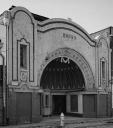Chicago, Ill.
Hull-House
800 South Halsted Street
In 1889, Jane Addams and Ellen Gates Starr, intimate companions since their college days, founded one of the most famous social experiments in this country’s history, Hull-House. It was their intention, Addams wrote later, “to rent a house in a part of the city where many primitive and actual needs are found, in which young women…might learn of life from life itself….”
The house they located was built in 1856 for Charles Hull, a prominent Chicagoan. Addams described the building as “a fine old house…, surrounded on three sides by a broad piazza which was supported by wooden pillars of exceptionally pure Corinthian design and proportion.” It stood, she noted with amusement, “between an undertaking establishment and a saloon.” Though the house was being used for offices and storerooms for a neighboring factory, Addams and Starr were able to rent the second floor and a downstairs drawing room, and the following year, they obtained the lease on the entire building. They furnished it with “a few bits of family mahogany” and items from their travels abroad and officially took up residency in September, 1889.
In an era when foreigners were feared and xenophobia was rampant, Addams, Starr, and the women who came to work with them offered immigrants (mainly Italian) education, medical care, guidance, and day care facilities. Expanding to thirteen buildings over the years, Hull-House became a model for settlement houses across the country. It was also a training ground for numerous reformers, including Julia Lathrop and Florence Kelley.
Addams’ biographers have generally ignored her personal life, assuming that she didn’t have one because she wasn’t attached to a man. Yet, though her intimacy with Ellen Starr had waned by the early 1890s, Addams shared a 40-year relationship with Mary Rozet Smith, who was one of the many idealistic young women from wealthy backgrounds who came to work at Hull-House. Smith routinely accompanied Addams on her lecture tours, and Addams was always sure to wire ahead to the hotel where they were staying for a room with a big double bed.
Although Hull-House as a social-service organization is still in existence, the original building at Polk and Halsted is now a museum, under the auspices of the University of Illinois-Chicago.











You must be logged in to post a comment.